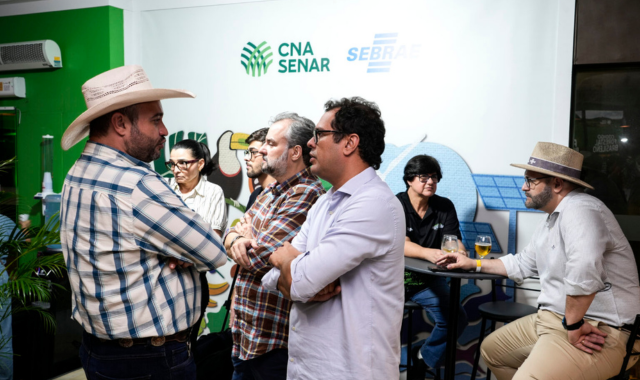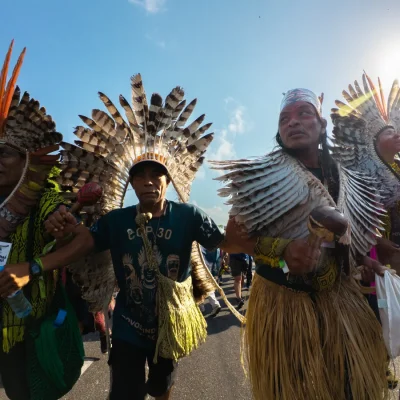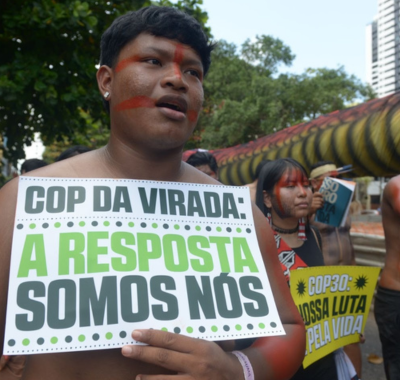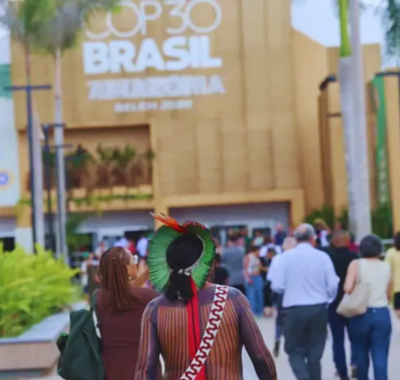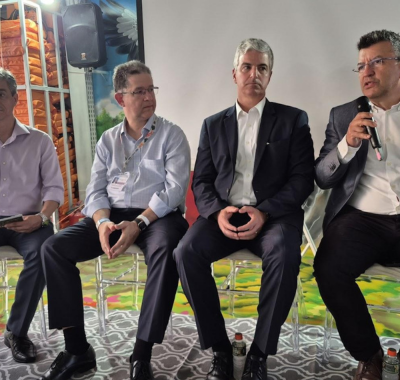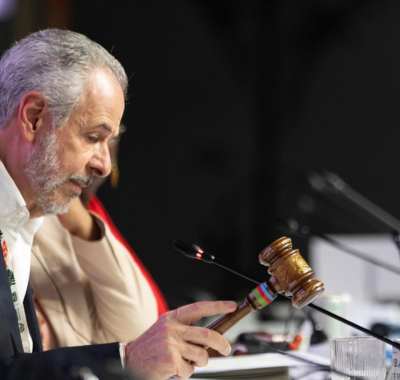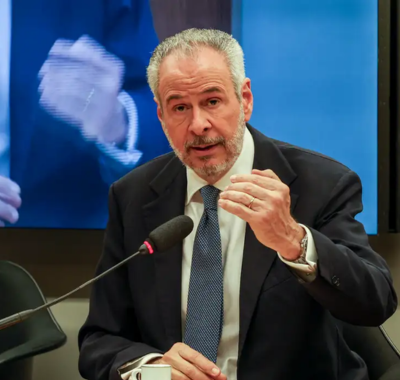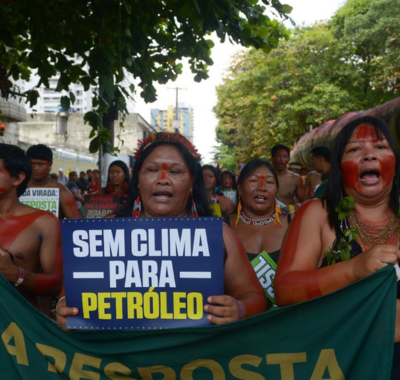Major Polluter, Livestock Farming Presents Itself as a ‘Climate Solution’ at VIP BBQ at COP30
At Agrizone, Embrapa’s area during COP30, the meat industry offers a barbecue and presents the sector as ‘sustainable,’ while data points to high levels of emissions and deforestation, degraded pastures, and low technology
By Helen Freitas
Translated by Diego Lopes/Verso Tradutores
FROM BELÉM (PA) — Medium-rare meat circulating through the room, cold draft beer, a table full of side dishes and the samba-pagode of the local band Frutos do Nosso Quintal. This is how Monday (17) ended for Abiec (Brazilian Association of Meat Exporting Industries) at COP30.
The barbecue hosted by the organization at the CNA (Confederation of Agriculture and Livestock) pavilion within Agrizone, aimed, according to the invitation, to “highlight the excellence of Brazilian beef,” featuring certified cuts and guest chefs. In practice, it was a VIP event to please partners and authorities and reinforce the narrative that livestock farming is part of the solution to the climate crisis.
The area set up by Embrapa (Brazilian Agricultural Research Corporation) for COP30 and with CNA as the main sponsor is an agribusiness space located 2 km from the official conference pavilion, specifically designed to reinforce the argument for the sector’s sustainability.
Access to the meat was controlled by yellow wristbands. Only those who had attended at least one of the four lectures of the day—or those close to the organization—were allowed in. When a journalist received her wristband, the president of Abiec, Roberto Perosa, interrupted jokingly: “Are you going to give her the wristband? Is she a vegetarian?” The press officer laughed and replied: “She deserves it.”
Security guards barred anyone without a wristband. Even the dogs that roam around Agrizone were kept outside. Some officials, however, entered without difficulty.
One of the most important guests entered discreetly: the Minister of Agriculture, Carlos Fávaro. He has been using a building next door as his office during COP30. When approached by Repórter Brasil, he said he was on “leisure time” and would not give an interview.
Also present at the barbecue was wood trader Silvério Fernandes. In 2002, three years before she was murdered, American missionary Dorothy Stang told the Federal Police that Fernandes had threatened her. According to the nun, the producer had said that if anyone invaded her land, she would “have blood up to her ankles.”
UN study suggests that meat consumption “sustains” global warming
Late Monday afternoon, the CNA hall at Agrizone was packed: ranchers, politicians, technicians, and drivers. There was even a car from the Pará state agricultural defense agency parked in front of the space.
Abiec doesn’t always receive this kind of attention at Agrizone. Its official stand is across the street, in a simple building with almost no activity. There, most of the time, are only exhibitors. Presenting livestock farming as part of the solution to climate change is no trivial endeavor. More than five years ago, an IPCC report concluded that the “high consumption’ of meat and dairy products “sustains” global warming.
In Brazil, the expansion of agriculture and livestock farming was responsible for 97% of the loss of native vegetation in the last six years, according to the MapBiomas Annual Deforestation Report.
During this period, Brazil’s methane footprint has increased by 6% since 2020. If it were a country, Brazilian livestock farming would be the 7th largest emitter in the world. This finding contradicts the promises made by the sector.
At COP26 in Glasgow, Scotland, Brazil signed the Global Methane Commitment (which foresees a 30% reduction in methane emissions by 2030) and the Leaders’ Declaration on Forests (which calls for zero deforestation and land degradation by the same year).
When questioned by reporters during the barbecue about the increasing impact of livestock farming, Roberto Perosa, president of Abiec, seemed hopeful. “I am certain [that the goals will be met]. We have this study that says that by 2050 we will reduce CO2 emissions from livestock farming and industry by 80%,” he said. “And if we add public policies, we can achieve up to a 93% reduction in greenhouse gas emissions,” he added.
In Perosa’s view, such results could be achieved while simultaneously expanding beef production. “Our Brazil will be largely responsible for the increase in meat production over the next 10 years,” he stated.
The sector presents livestock farming as a climate solution, but the numbers challenge this claim
Throughout the day, a series of lectures attempted to present sustainability initiatives in the sector. “Imagine, ladies and gentlemen, if it weren’t for Brazil, how much would 1 kg of meat be worth in the world today? In other words, we are the solution for the planet,” stated Gedeão Silveira Pereira, vice-president of the CNA.
For him, the “condemnation” of livestock farming as a climate villain is unfair. He said that the metrics used to measure greenhouse gas emissions were designed for countries with temperate climates and are not suitable for Brazil. In his view, tropical pasture acts as a kind of carbon vacuum cleaner. “The cattle emit methane. But the pasture they eat is subtracting carbon,” he said, without presenting studies to support his claim.
Pereira also lashed out against what he calls the “internal enemy.” He said he fears Brazilian regulations related to agriculture more than the new European restrictions on importing products linked to deforestation. “We don’t only have to fight against the external public, for competition and market share. We have to fight, and much more so, with our own people within the country who don’t want Brazil to develop,” he stated.
At another table, researchers from Embrapa Gado de Corte, Embrapa Acre, and Embrapa Pecuária Sul, research units of the federal institution, presented the report “Brazilian Livestock Farming as Part of the Solution to Climate Change”, outlining solutions for livestock farming.
The central thesis is that tropical livestock farming can simultaneously guarantee global food security and contribute to Brazil’s emissions reduction targets. The solution would involve increasing productivity per hectare, slaughtering younger animals, using genetics and supplementation, restoring pastures, and adopting systems such as integrated crop-livestock-forestry systems.
The solution to reduce the high rate of methane emissions would be to shorten the animal’s lifespan in the pasture: the slaughter of cattle, for example, would occur closer to two years of age, instead of three years.
According to Abiec, there has been a 183% increase in livestock productivity in recent decades. The use of technology is said to have prevented the occupation of an additional 326 million hectares of native vegetation. However, a study released by the institution during COP30 shows that 76% of pastureland operates with low technology, with an average productivity of 37 kilograms of carcass per hectare per year.
Regarding emissions, the numbers also show the challenge of converting Brazilian livestock farming as part of the solution to the climate crisis. Brazil is currently the 5th largest emitter of greenhouse gases on the planet. Agriculture and livestock farming accounted for 70% of national emissions in 2024, according to data from SEEG, a platform of the Climate Observatory.
This report was produced by Repórter Brasil, through the Collaborative Socio-environmental Coverage of COP 30. Read the original report at https://reporterbrasil.org.br/2025/11/pecuaria-churrasco-cop30/

